W. M. Brutton | |
|---|---|
| Born | 1861 London, England |
| Occupation | Architect |

William Mortimer Brutton (1861 – date of death unknown) was a British architect.
W. M. Brutton | |
|---|---|
| Born | 1861 London, England |
| Occupation | Architect |

William Mortimer Brutton (1861 – date of death unknown) was a British architect.
He was born in Kensington, London, the second son (and second of three children) of William Courtenay Brutton (1831–1878), who was a solicitor, originally from Exeter his wife Hannah Bridge (1836–1879).
Brutton has been described as a "prolific pub architect". [1]
His works include the Fitzroy Tavern, a public house situated at 16 Charlotte Street in the Fitzrovia district of central London, to which it gives its name. The building was originally constructed as the Fitzroy Coffee House, in 1883, and converted to a pub (called “The Hundred Marks”) in 1887, by Brutton.
In 1896, Brutton designed the King's Head, Tooting, which CAMRA describe as "an historic pub interior of national importance". [2]
Also in 1896, Brutton designed the St James's Tavern in Denham Street, in central London. [3]
In 1897, Brutton was responsible for the remodelling and extension of the Alhambra Theatre in Leicester Square, now the site of the Odeon Leicester Square. [4]
Brutton also designed the Princess Victoria in Shepherd’s Bush. [5]
In October 1880, he married Ada Louise Pidding (1864-). They had a daughter, Ethel Mortimer Brutton (1881-)

Covent Garden is a district in London, on the eastern fringes of the West End, between St Martin's Lane and Drury Lane. It is associated with the former fruit-and-vegetable market in the central square, now a popular shopping and tourist site, and with the Royal Opera House, itself known as "Covent Garden". The district is divided by the main thoroughfare of Long Acre, north of which is given over to independent shops centred on Neal's Yard and Seven Dials, while the south contains the central square with its street performers and most of the historical buildings, theatres and entertainment facilities, including the London Transport Museum and the Theatre Royal, Drury Lane.

Fitzrovia is a district of central London, England, near the West End. The eastern part of area is in the London Borough of Camden, and the western in the City of Westminster. It has its roots in the Manor of Tottenham Court, and was urbanised in the 18th century. Its name was coined in the late 1930s by Tom Driberg.

Arnold is a market town and unparished area in the Borough of Gedling in the ceremonial county of Nottinghamshire in the East Midlands of England. It is situated to the north-east of Nottingham's city boundary. Arnold has the largest town centre in the Borough of Gedling and the most important town centre in the northeastern part of the conurbation of Greater Nottingham. Gedling Borough Council is headquartered in Arnold. Since 1968 Arnold has had a market, and the town used to have numerous factories associated with the hosiery industry. Nottinghamshire Police have been headquartered in Arnold since 1979. At the time of the 2011 United Kingdom census, Arnold had a population of 37,768.

The Fitzroy Tavern is a public house situated at Charlotte Street in the Fitzrovia district of central London, England, owned by the Samuel Smith Brewery.
The Alhambra was a popular theatre and music hall located on the east side of Leicester Square, in the West End of London. It was built originally as the Royal Panopticon of Science and Arts opening on 18 March 1854. It was closed after two years and reopened as the Alhambra. The building was demolished in 1936. The name was also adopted by many other British music hall theatres located elsewhere; in Bradford, in Hull and in Glasgow etc. The name comes from association with the Moorish splendour of the Alhambra palace in Granada, Spain.
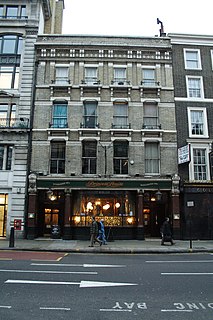
The Princess Louise is a public house situated on High Holborn, a street in central London. Built in 1872, it is best known for its well-preserved 1891 Victorian interior, with wood panelling and a series of booths around an island bar. It is a tied house owned by the Samuel Smith Brewery of Tadcaster, Yorkshire.

Thomas Henry Nowell Parr FRIBA was a British architect, best known for designing pubs in west London. Many of these were built while Parr was "house architect" for Fuller's Brewery. Parr designed various buildings in Brentford while he was surveyor and then architect to the Council from 1894 to 1907.

The King's Head is a Grade II listed public house at 84 Upper Tooting Road, Tooting, London SW17 7PB.
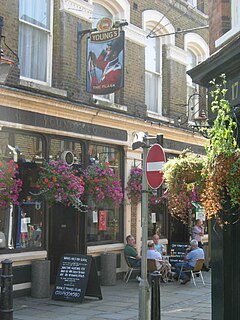
The Flask is a Grade II listed public house at 14 Flask Walk, Hampstead, London, on the site from where the trade in Hampstead mineral water was run, and which is mentioned in the eighteenth century novel Clarissa. It has been owned by Young's Brewery since 1904.
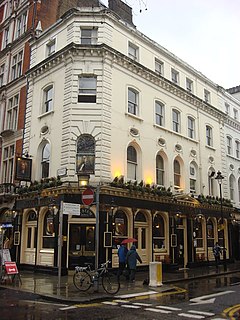
The Museum Tavern is a Grade II listed public house at 49 Great Russell Street, Bloomsbury, London.
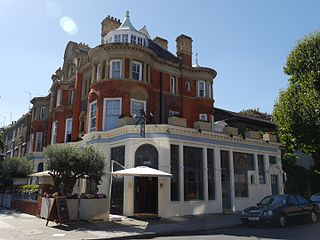
Crocker's Folly is a Grade II* listed public house at 24 Aberdeen Place, St John's Wood, London. It was built in 1898, in a Northern Renaissance style, and was previously called The Crown. Geoff Brandwood and Jane Jephcote's guide to heritage pubs in London describes it as "a truly magnificent pub-cum-hotel" with "superb fittings", including extensive use of marble. The architect was Charles Worley.

The Star Tavern is a Grade II listed public house at 6 Belgrave Mews West, Belgravia, London SW1.

The Viaduct Tavern is a Grade II listed public house at 126 Newgate Street, Holborn, London. It was built in 1865 and the interior was remodeled in 1898–1900 by Arthur Dixon. It is on the Campaign for Real Ale's National Inventory of Historic Pub Interiors.

The Winchester is a former public house at 206 Archway Road, Highgate, London N6 5BA.
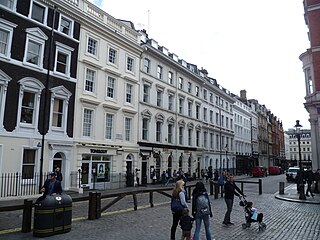
Henrietta Street is a street in Covent Garden, London, that was once home to a number of artists and later became the location of many publishing firms.

The Golden Cross is a Grade II listed public house at the junction of Customhouse Street and Hayes Bridge Road in the centre of Cardiff, Wales. The current building dates from 1903 and is noted for its distinctive ceramic tiling.

The Wheatsheaf is a public house at Mill Lane, St Helens, Merseyside WA9 4HN, England. It was built in 1936–1938 by the brewery Greenall Whitley & Co. Ltd of Warrington, to a design by the architect W. A. Hartley.
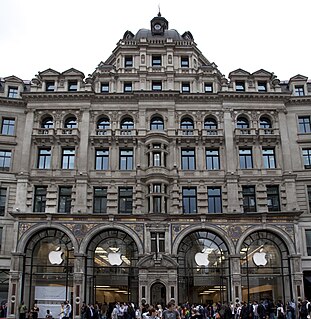
George Dennis Martin, F.S.I. was an English architect based in London.

The Commercial is a public house at 210-212 Railton Road, Herne Hill, London. It is cited in 'The CAMRA Regional Inventory for London' as being one of only 133 pubs in Greater London with a pub interior of special historic interest, most notably for its, "Original counters, bar-back, fireplaces and much fielded wall panelling" dating from the 1930s. In July 2016, Lambeth Council designated The Commercial as a locally-listed heritage asset of architectural or historic interest, being described as a, "Two-storey Neo Georgian style inter-war pub with a three-part convex façade which follows the curve of the building line".